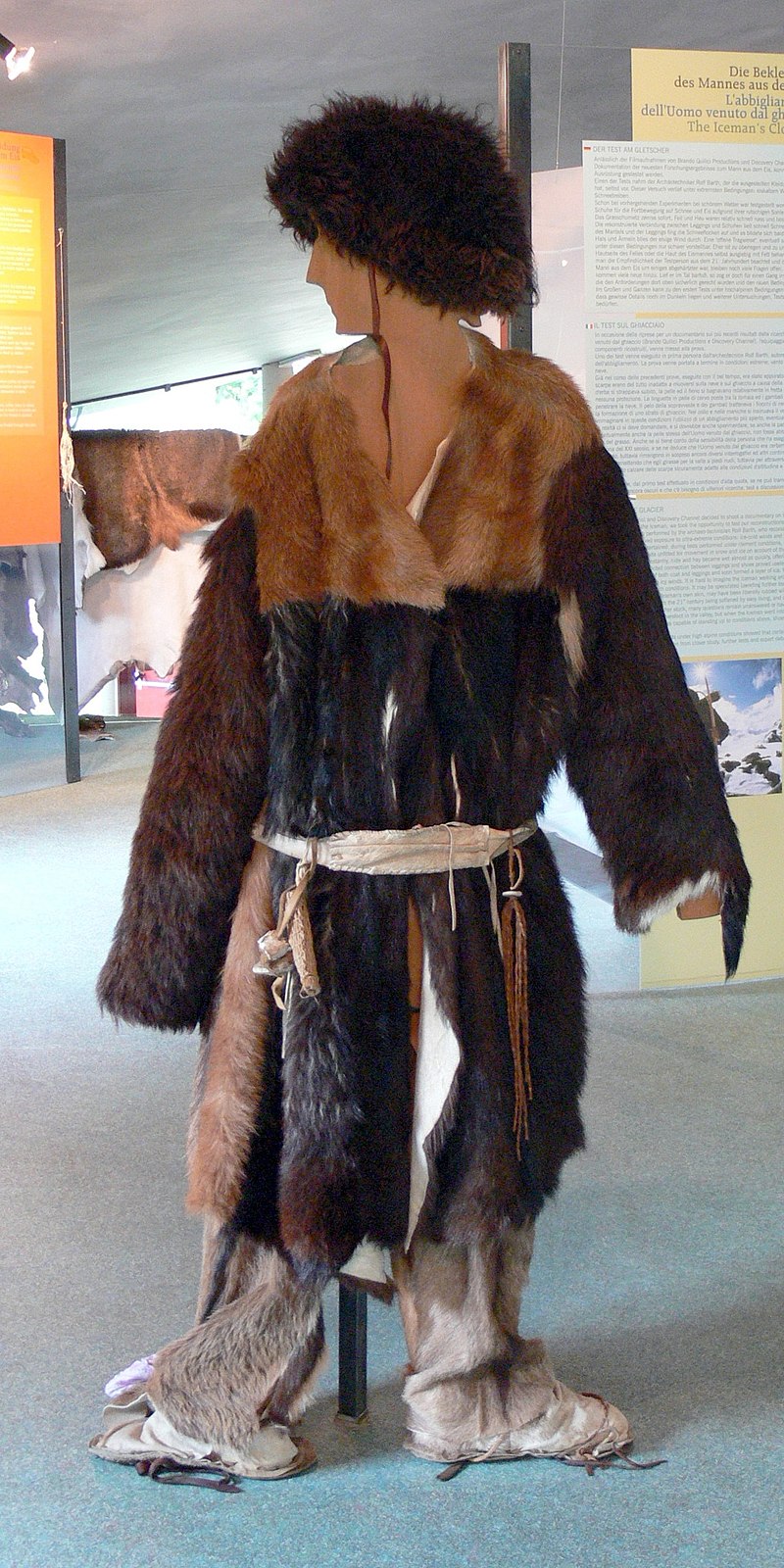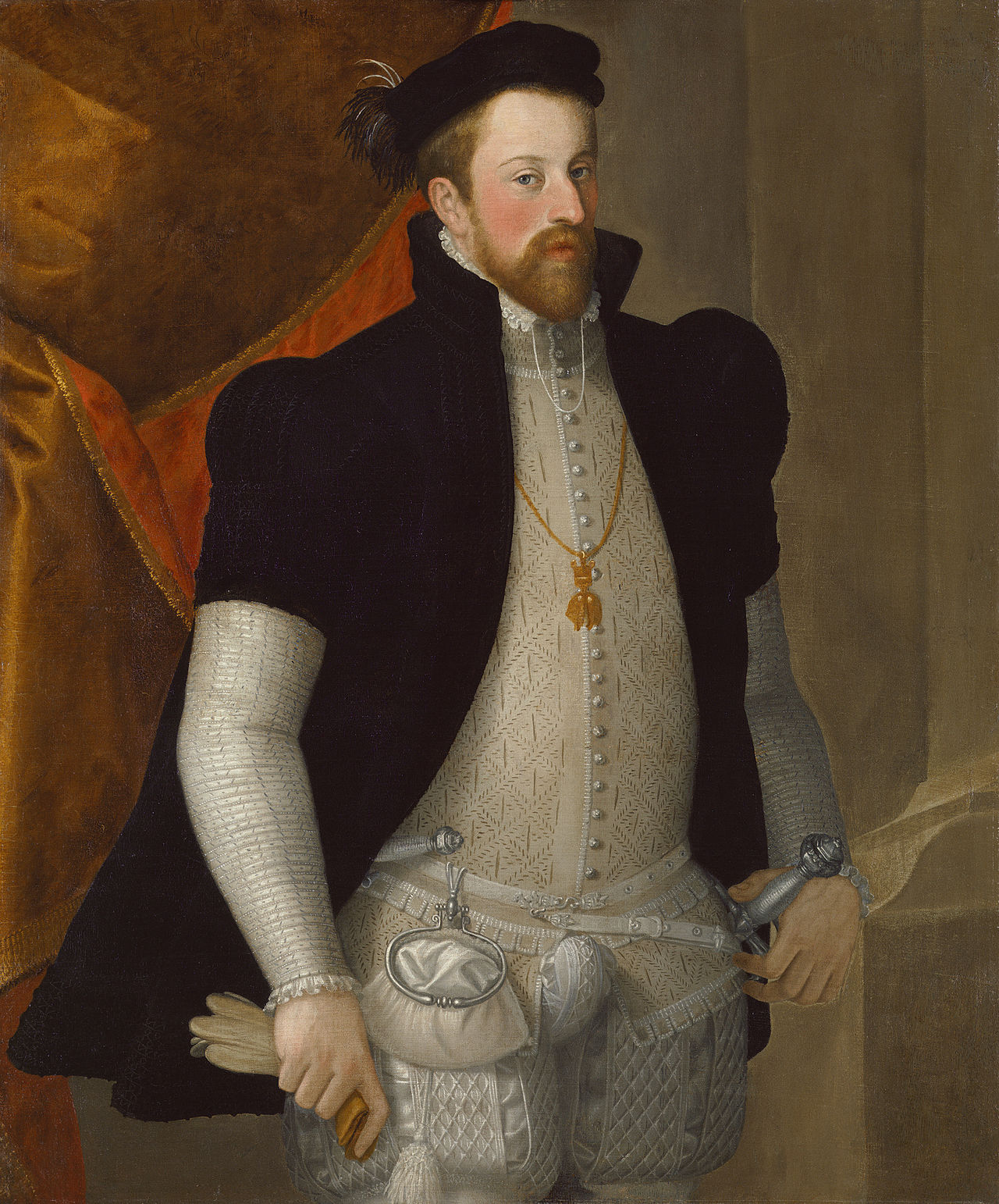Pockets
Pocket History
It is hard to say when pockets were invented. One reason is because you would have to define “pocket” but also because they were so ubiquitous there is no one person who invented the pocket.
The oldest account of a pocket-like garment was found in 1991. There was a 5,300 year old man mummified in the Alps. (3,300BCE). He is known as Ötzi the Ice Man. This was a perfectly preserved and clothed specimen— A treasure trove of information about what it was like to live in the ancient world. However, today we are only going to discuss his pocket. It was a pouch that was sewn to his belt and it had a scraper, a drill, flint flake, bone awl, and a bit of dried fungus.

A reconstruction of the outfit worn by Ötzi
by Wolfgang Sauber, CC BY-SA 3.0
During the Medieval period (1060’s – 1480’s) we used pouches that were usually made of leather or cloth that were tied to the belt. Whether that belt was rope, leather, or string these pouches were tied and hung on the outside of the clothing which is something that will change soon enough.
Unlike a lot of the things we have covered so far pockets were not a classist item: Both rich and poor alike had a pouch or pocket that carried needed items. Now, what it was made of depended on how much money you had but the ability to obtain one was not.
The next big thing for pockets was where they were placed. As society grew and people moved around more, security became a concern. The plague (of 1350) had a lot to do with that. Such a large number of the population dying meant that there was more incentive for people to leave their hometowns. If someone who worked in the field died, the land owner needs someone to take their place so they would entice people from smaller surrounding villages to come work for them which caused people to move around more. An influx of strangers in town meant you had to be more cautious.

Archduke Ferdinand II of Austria with a pocket tied to his belt (~1557)
I’m not saying that the plague had any real influence on pocket culture but it was a major event that caused people to mix more. Society grows, and now we have pockets on the inside of our garments. For men this mostly meant tying pouches up under their jackets or tunics while women could tie on pockets that went under their dresses that they could access through slits in the fabric. That is not to say that pockets were strictly worn under garments. Merchants or other professions that regularly needed access to their pockets for items or to exchange money would often wear them on the outside but I have a feeling the majority of these people were men. This did leave them open to more nefarious actors on the streets where someone could get their hand in your pocket or cut the pocket off the wearers body altogether. London Archives have criminal court records from 1674-1913 with over 4,000 pages of records concerning pocket related criminal activity. At this time they were usually referred to as cut purses.
I do want to quickly talk about women's tie-on pockets (which is a modern distinction as in their time they were just pockets). These pockets where huge. You could carry a book, writing materials, an apple or some kind of snack and that’s just one pocket. They usually had one on each side. And because the pockets were concealed under the dresses there was a sense of privacy, not only with the things that were inside that were only known to the wearer but also in the decorative patterns on the pocket itself. There was a lot of pressure for them to adhere to specific designs according to fashion but there was little confinement with what women could do with their pockets. They could have personal motifs or initials or more elaborately embroidered silk designs. A lot of the time they were patch worked because hand woven fabric was very precious, and you used as much of every piece that you could.

A recreation of traditional pockets
In the 17th century pockets began being sewn into men’s garments only. Which I kind of understand because they were still rocking the pouch under the jacket or just out in the open and women’s tie on pockets were pretty awesome.
Henry the 8th (early 1500’s) did have a pocket in his hose (which was those big fluffy kind of bulbous short pants) but I’m not sure if he had that because he was the king and he could have his tailor do something special like that for him or if it was more common in the wealthy circles.
We also need to cover women’s pockets in the mid 18th century. It was a brief golden era that had never been so good and it will probably never be that good again. This was a period of time where the fashionable silhouette involved very wide hips. This opened a wide door for huge pockets. They had hoop skirts with built in structure to lift the skirts away from the body leaving a very large space for pockets to be filled to their full capacity. Additionally, they had small pockets at the top of their dresses sewn into the stays (which was like a corset) and then they would put stomachers which matched the dress in front of that. They were perfect for holding small personal effects. Granted, this was not an experience that all women shared; this was enjoyed mainly by the upper class who would have worn something this especially impractical.
There are some sources that I can’t really confirm, which say that during the French Revolution in the late 18th Century, women’s pockets were banned because they were seen as dangerously secretive. They were reportedly worried that they would be used to carry secret messages. Again, no one seems certain that this is true. Simultaneously, the fashion was trending to slimmer dresses which couldn’t accommodate pockets, so who knows which one happened first.
By the 19th century (the regency period) women's fashion changed pretty dramatically to include a high waistline and a very slim figure which was not conducive for large pockets which is when the reticule came into fashion. It was a small hand bag that was supposed to take the place of the pocket. And this is when women get angry. Before this I believe we had been pretty happy with our lot in pocket life. I found a newspaper clipping that acknowledged the frustration being experienced between women: “The reticule is not and never can be a fair representation of the substantial and capacious pockets which our ancestors wore. They were proper pockets such as reticules never can be.”
Again, it is probably important to mention these were upper class women’s issues. You had to have money to buy the new fashions in order for this to affect you so personally. But it did mark the area of pocket inequality that women still face today.
So we know that as fashion moves along there is no exact date that everyone collectively decides to move from one style to the next but we do know that around the mid 19th century the tie on pocket is getting left behind. By 1870 there are written references and complaints about women’s pockets. “The feminine system of pockets is wretchedly meager and deficient and stands greatly in need of reform.” That is from an 1897 article literally titled A Plea for Pockets (A complaint about amount not size).
That isn’t to say that the sewn in pockets were all bad. They undoubtably were more secure since they were sewn into the garment but it also led to pockets being sewn into strange places like the very back of the dress or anywhere where it could be hidden under a ruffle. The other issue with sewn in pockets was that they had to be sewn into every garment, which was costly and a lot of manufacturers considered to be superfluous for women's clothing. Because women don’t need access to personal items, they should be home with all their things anyway and if they are out they should be with a man who has pockets.
Now it gets worse. Up until now the pockets that we did have were at least sizable. We didn’t have many but the ones we had were big enough to carry items but as fashion progressively got slimmer we stopped wearing bulky petticoats— Some of us wouldn’t wear skirts at all. As we get into the mid 20th century pockets have diminished in size.
Of course, men have also gone through plenty of fashion changes themselves. There was a period of fashion in the late 18th/early 19th century where men wore skin tight britches and the pockets were small. The difference is they were compensated on the upper body with more pockets on the inside and outside coat and waistcoat, without the wearer being expected to purchase an external pocket or hand bag. I also want to mention there was this idea that it was an obscene gesture to have your hands in your trouser pockets because that’s where your genitals are and heaven forbid anyone think about those disgusting appendages. If you see a really old picture of a man thrusting his hands in his pockets that was a vulgar statement. During the suffragette movement you will see some photos of women in pantsuits with their hands in their pockets and that was most definitely a statement of self ownership.
Pockets Today
Let’s talk about modern pockets, the kind you and I experience every day. In a normal pair of women’s jeans the pocket depth is barely 4 inches compared to a man’s pair of jeans at 8 inches. On average mens pockets are 3 inches deeper than women’s. And that’s to say nothing of the horrific blasphemy that is the fake pocket.
There are some brands fighting against the trend of shrinking pockets. Julie Sygiel is the founder of the pockets project. She has made It her mission to create work-friendly, professional dresses that are also functional. She promises every dress you buy from her site will feature pockets that are at least 8.5 inches deep because we’ve got things to do and snacks to carry.